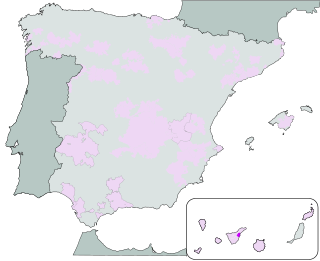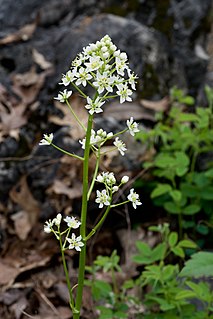
In Greek mythology, Laertes was the father of Odysseus, an Argonaut, and a participant in the hunt for the Calydonian Boar. His title was King of the Cephallenians, an ethnic group who lived both on the Ionian islands and on the mainland, which he presumably inherited from his father Arcesius and grandfather Cephalus. His realm included Ithaca and surrounding islands, and perhaps even the neighboring part of the mainland of other Greek city-states.
In Greek mythology, Anticlea or Anticlia was the daughter of Autolycus and Amphithea and mother of Odysseus by Laërtes. The divine trickster and messenger of the gods, Hermes, was her paternal grandfather.

Melanthiaceae, also called the bunchflower family, is a family of flowering herbaceous perennial plants native to the Northern Hemisphere. Along with many other lilioid monocots, early authors considered members of this family to belong to the family Liliaceae, in part because both their sepals and petals closely resemble each other and are often large and showy like those of lilies, while some more recent taxonomists have placed them in a family Trilliaceae. The most authoritative modern treatment, however, the APG III system of 2009, places the family in the order Liliales, in the clade monocots. Circumscribed in this way, the family includes up to 17 genera.

Melanthieae is a tribe of flowering plants within the family Melanthiaceae. Molecular phylogenetic studies in the 21st century have resulted in a large-scale reassignment of many of its species to different genera; in particular the genus Zigadenus (deathcamases) has been restricted to a single species, Zigadenus glaberrimus. Plants contain alkaloids, making them unpalatable to grazing animals; many are very poisonous to both animals and humans.

Muehlenbeckia or maidenhair is a genus of flowering plants in the family Polygonaceae. It is native to the borders of the Pacific, including South and North America, Papua New Guinea and Australasia. It has been introduced elsewhere, including Europe. Species vary in their growth habits, many being vines or shrubs. In some environments, rampant species can become weedy and difficult to eradicate.

Anticlea elegans, formerly Zigadenus elegans, is also known as mountain deathcamas, elegant camas or "alkali grass". It is not a grass, but belongs to the trillium family, Melanthiaceae.
Deathcamas or death camas refers to several species of flowering plant in the tribe Melanthieae. The name alludes to the great similarity of appearance between these toxic plants, which were formerly classified together in the genus Zigadenus, and the edible camases (Camassia), with which they also often share habitat. Other common names for these plants include deadly zigadene, hog potato and mystery-grass.

Abona is a Spanish Denominación de Origen Protegida (DOP) for wines located on the southern coastline of Tenerife,, and acquired its DO in 1996.
In Greek mythology, Ctimene was the younger sister of Odysseus, the legendary king of Ithaca. She was the daughter of Laertes and Anticlea, and was raised by them alongside the servant Eumaeus, who was treated almost as her equal. Ctimene was married off to Eurylochus of Same for a massive bride-price. Her husband accompanied Odysseus on his journey from Troy but, like all of Odysseus's men, died before reaching home.

Valle de Güímar is a Spanish Denominación de Origen Protegida (DOP) for wines located along the south-eastern coastline of Tenerife, and acquired its DO in 1996.

Anticlea is a genus of flowering plants in the family Melanthiaceae, tribe Melanthieae. Molecular phylogenetic studies in the 21st century have resulted in number of changes to placements within this tribe. Anticlea was long submerged into the genus Zigadenus; however its separate position has been confirmed. Some species were also moved from Stenanthium into Anticlea. Members of Anticlea may also be distinguished from other members of the former genus Zigadenus, the deathcamases, by the presence of narrow tepals with a single, conspicuous, bilobed gland. It also has a wider distribution, occurring in Asia and much of North and Central America, ranging south to Guatemala.

Stenanthium is a North American genus of flowering plants in the tribe Melanthieae of the family Melanthiaceae.

Triplarina is a genus of 7 species of shrubs in the family Myrtaceae. They occur in New South Wales and Queensland in Australia.

Zigadenus is a genus of flowering plants now containing only one species, Zigadenus glaberrimus, the sandbog death camas, found in the southeastern United States from Mississippi to Virginia. Around 20 species were formerly included in the genus, but have now been moved to other genera.

Charaxes anticlea, the small flame-bordered charaxes, is a butterfly in the family Nymphalidae. It is found in Senegal, Guinea-Bissau, Guinea, Sierra Leone, Liberia, Ivory Coast, Ghana, Togo, Nigeria, Cameroon, Gabon, the Republic of the Congo, the Central African Republic, Angola, the Democratic Republic of the Congo, Uganda, Kenya, Tanzania and Zambia. The habitat consists of forests, including dry forests, somewhat degraded forests and dense riverine vegetation.

Toxicoscordion nuttallii is a species of poisonous plant native to the south-central part of the United States.
Anticlea is a character in Greek mythology.
Polygonum rupestreKar. & Kir. is a species of flowering plant in the family Polygonaceae, native to Kazakhstan, Kyrgyzstan, Tajikistan and Uzbekistan. It was first described by Grigorij Silych Karelin and Ivan Kirilov in 1841.
Persoonia volcanica is a species of flowering plant in the family Proteaceae and is endemic to eastern Australia. It is an erect shrub with hairy young branchlets, egg-shaped to oblong leaves, and yellow flowers borne in groups of up to twenty on a rachis up to 180 mm (7.1 in) that usually continues to grow after flowering, each flower with a leaf at its base.
Eucalyptus volcanica is a species of tree that is endemic to northern New South Wales. It has rough, fibrous to flaky bark on the trunk, smooth bark above, lance-shaped or curved adult leaves, flower buds in groups of seven, white or creamy white flowers and cup-shaped or barrel-shaped fruit.












